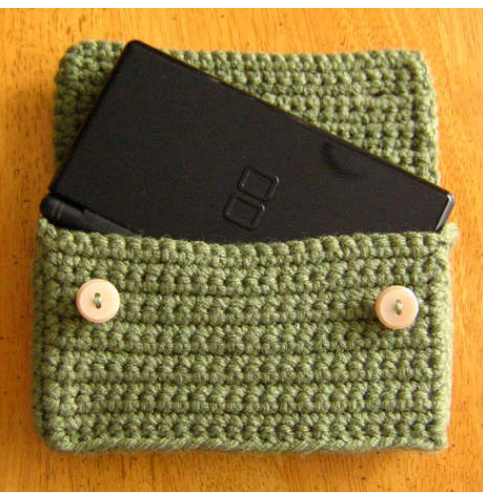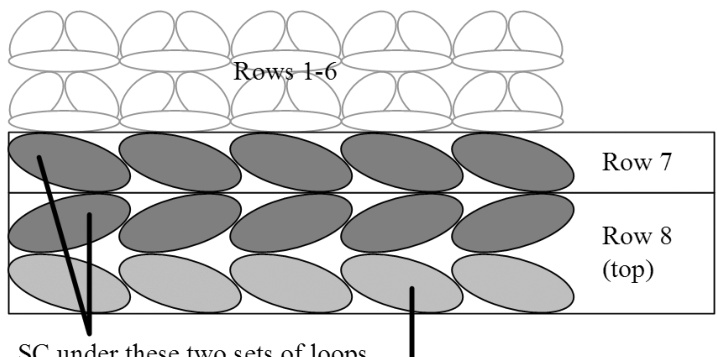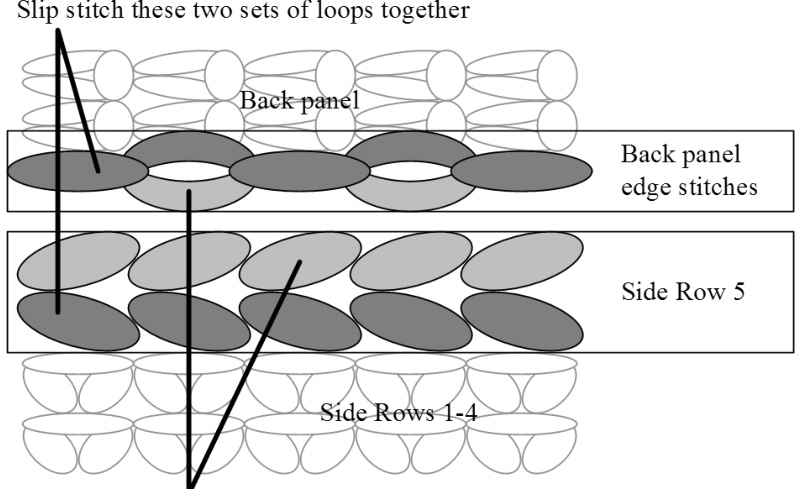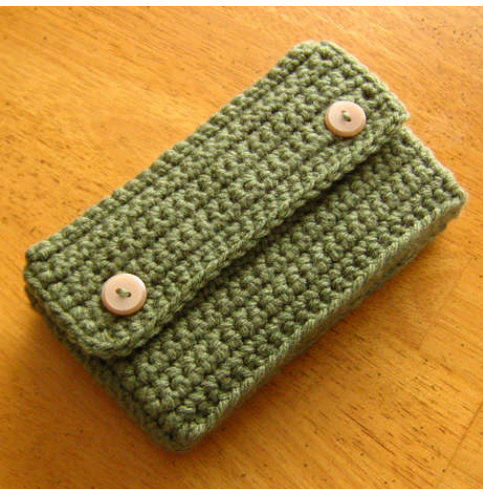NINTENDO DS LITE/3DS POCKET
@ 2010-2015 Julie Mnemosyne (stella.mnemosyne@gmail.com)

PATTERN NOTES
· This pattern has no sewn seams - all seaming is integrated into the crocheting. Unless otherwise noted, always single crochet into the stitch at the base of a turning chain to get straight sides. I'm right-handed, which means that all of the diagrams in this pattern are drawn from a right-handed perspective; if you're left-handed, mentally flip the images horizontally to get the appropriate orientation. I might include storage for game cartridges in a later version of this pattern, once I work out an efficient method of adding pockets, so keep an eye out for that. The only difference between the DS Lite and 3DS pockets is at Rows 30 and 31, where the charging cord hole is creat YARN About 1 to 1.5 oz of your favorite aran-weight yarn HOOK SIZE G (4.0 mm) crochet hook or smaller/larger as needed to obtain gauge. GAUGE 17.5 sts and 20 rows = 4 in. (10.2 cm) in sc NOTIONS Yarnneedle Smaller size crochet hook for use in tight spots (optional) Two buttons (obtain these after you've finished making the pocket so that you can make sure that they're the right size foryour buttonholes) Thread (optional) Sewing needle (optional) CROCHET STITCHES AND TECHNIQUES REQUIRED (US TERMS) Chain (ch), single crochet (sc), single crochet into front loop only (flsc), single crochet into back loop only (blsc), slip stitch (sl st), joining yarn SEWING STITCHES REQUIRED Buttonhole stitch or whipstitch PATTERN BEFORE YOU BEGIN The pocket pattern is split into sections for easier reference - you do not break your yarn between sections, as the pocket is made as one whole piece. Note: This pattern is designed to fit perfectly -not too snugly, not too loosely. I would suggest checking the size of your work against the DS/3DS it's intended to hold at the points indicated in the pattern. POCKET TOP FLAP Ln Z3 sts pius 1 turning cn (24 cns). Row 1: Turn, skip first ch next to hook, sc in ea ch (23 scs). Row 2: Ch 1, turn, sc in first 2 sts, ch 2, skip next two sts, sc in next 15 sts, ch 2, skip next two sts, sc in last 2 sts (19 scs and 2 ch-2 sps). Row 3: Ch 1, turn, sc in first 2 sts, sc twice in ch-2 sp, sc in next 15 sts, sc twice in ch-2 sp, sc in last 2 sts (23 scs). Rows 2 and 3 create two buttonholes on the top flap. Row 4 to 7: Ch 1, turn, sc across (4 rows of sc). Check against DS/3DS for width after Row 4. Row 8: Ch 1, turn, blsc across. Row 9: Ch 1, turn, sc in free loops of Row 7 (the ones you didn't sc in Row 8) AND back loops of Row 8, treating these two sets of loops as one set of normal sc loops. See diagram below for clarification if needed.

This set of loops becomes the spine If you did this correctly, the front loops of Row 8 will form a spine on the right side of your fabric. When the top flap is folded into position along this spine, the fold creates a corner that corresponds to one of the corners on your DS/3DS, providing a bit of extra protection against bumps. Rows 10 to 12: Repeat Row 4 (3 rows of sc). Row13: Ch 1, turn, flsc across. Row14: Ch 1, turn, sc in free loops of Row 12 (the ones you didn't sc in Row 13) AND front loops of Row 13, treating these two sets of loops as one set of normal sc loops. This has the same effect as Rows 8 and 9 but, since you're working on the wrong side of your fabric, you have to change the orientation of the stitches to shape the corner in the correct direction. POCKET BACK PANEL Rows 15 to 27: Repeat Row 4 (13 rows of sc). Check against DS/3DS for depth after Row 15. BOTTOM PANEL Rows 28 to 29: Repeat Rows 8 and 9. NINTENDO DS LITE POCKET Row 30: DS: Ch 1, turn, sc in first 14 sts, ch 4, skip next 4 sts, sc in last 5 sts (19 scs and 1 ch-4 sp). 3DS: Ch 1, turn, sc in first 3 sts, ch 4, skip next 4 sts, sc in last 16 sts (19 scs and 1 ch-4 sp). Check against DS/3DS for height. Row 31: DS: Ch 1, turn, sc in first 5 sts, sc 4 times in ch-4 sp, sc in last 14 sts (23 scs). 3DS: Ch 1, turn, sc in first 16 sts, sc 4 times in ch-4 sp, sc in last 3 sts (23 scs). Rows 30 and 31 create an opening.for the charger port on the DS/3DS. Row 32: Repeat Row 4. Rows 33 to 34: Repeat Rows 13 and 14. POCKET FRONT PANEL Rows 35 to 43: Repeat Row 4 (9 rows of sc). POCKET SIDE PANELS Row S1-1: Row S1-2: Ch 1, turn, sc in ea sc of previous row, ch 2 plus 1 turning ch (11 scs and Row S1-3: Turn, skip first ch next to hook, sc in ea ch, sc in ea sc, sl st into nearest edge st of bottom panel (13 scs, 1 sl st). Row S1-4: Row S1-5: Check against DS/3DS to see if there is enough room to slide the DS/3DS into the pocket - there should be very little to no gap or overlap between the side panel and back panel when the DS/3DS is in position. Seam: Fold your fabric so that the top of Row S1-5 and the lower 13 edge sts on the back panel line up. Rotate the fabric so that the live loop is oriented to start a new row. Ch 1, sl st one set of loops in Row S1-5 to the edge sts of the back panel (13 sl sts). See diagram below for clarification if needed.

These two sets of loops will be hidden on the inside This creates a finished seam on the outside of the edge, hiding the unfinished edge stitches inside. Catch-up stitches: Ch 1, sc into 2 top edge sts of side panel, ch 1, sc twice into back of second ch of Row S1-2, sc into back side of first ch of Row S1-2 (5 scs). This makes up half of the height difference between the side and the back panels when the top flap is closed, as well as moving the live loop into position to go across the front panel and start the second side. Row 44: Sc across Row 43 to other side of front panel. Repeat Row S1-1 (12 scs, not counting sl st). Ch 1, turn, sc in ea sc of previous row, ch 1 plus 1 turning ch (12 scs a Rows S2-3 to S2-5: Repeat Side 1, Rows 3-5. Repeat Seam from first side panel. Catch-up stitches: Ch 1, sc into 2 top edge sts of side panel, ch 1, sc twice into back of first ch of Row S2-2 (4 scs). Row 45: Sc across Row 44 to other side of front panel. POCKET TOP FLAP EDGING Catch-up stitches: Sc into first 2 scs on side panel, sc twice into corner st of side panel, sc across top of side panel, ch 1, sl st into closest edge st on back panel (6 scs, 1 sl st). This makes up the remaining height difference between the side and the back panels when the top flap is closed, as well as moving the live loop into position to start the edging. Edging: Sc into last edge st on back panel, sc around top flap to the same point on the other side of the back panel, with 2 scs in the front corners of the top flap. (12 sts + 2 sts + 21 sts + 2 sts + 12 sts = 49 sts) Itch-up stitches: Ch 1, sc across top of side panel, sc twice into corner st of side panel, sc into last 2 scs on side panel (5 Scs). Break off yarn and weave in ends. FINISHING s and charger port hole with buttonhole stitch or whipstitch. Position an You can use yarn and a yarn needle or thread and a sewing needle for finishing, whichever works for you. I used the full thickness of my yarn for reinforcing the holes with buttonhole stitch and then split a length of yarn into two sets of plies to sew on the buttons, since my buttons had smallish holes. CARRYING STRAP (OPTIONAL) Join yarn into top edge of one side panel, in the first stitch from where it connects to the back panel, leaving at least an 8 in. (21 cm) tail. Ch to desired length of the strap, sl st in corresponding st on the top edge of the opposite side panel. Row1: Sl st in next st in edge (serves as turning ch), turn, sc in ea ch, sl st in top edge of first side panel. Row2: Turn, sc across, sl st in top edge of opposite side panel. Row3: Repeat Row 2. Break off yarn about 8 in. (21 cm) from the end of the strap and use the ends to reinforce the join between the strap and the pocket as you weave them in. Have fun and happy gaming! If you have any questions or spot an error, please send me a message on Ravelry or email me at stella.mnemosyne@gmail.com.










